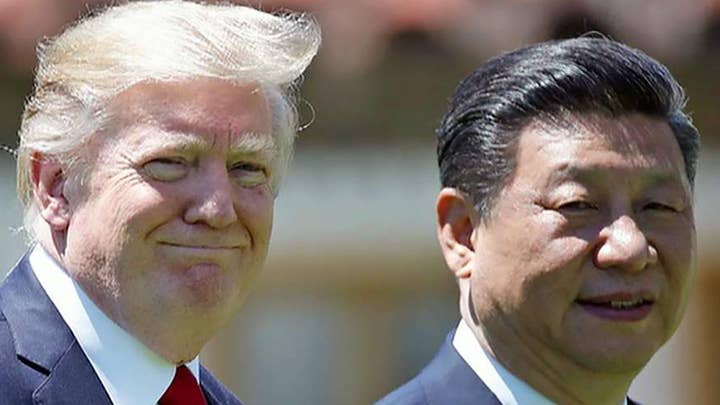US, China resume trade talks as China signals they may be more agreeable to a deal to end the trade war
A spokesman for China says they remain on equal footing as the U.S. to come to an agreement; Edward Lawrence reports from the White House.
President Trump is exposing China’s economic vulnerability, showing that the communist nation cannot maintain its rapid growth without it patently unfair mercantilist trade policies.
The Chinese government recently announced that its GDP growth for 2018 of only 6.6 percent – the country’s slowest rate of economic development since 1990. Growth in the fourth quarter declined to 6.4 percent. For the second half of 2018, Chinese investment, consumer spending, manufacturing and exports all slowed markedly with the current trade war with the U.S. hurting China more than anticipated.
And that’s assuming the numbers are accurate. Economists have long questioned the accuracy of China's official economic data. In any event, China’s economy is rapidly decelerating – and that’s no coincidence.
CHINA SHOULD THINK TWICE BEFORE THREATENING TO ATTACK AMERICANS
For the first time in decades, the U.S. has openly challenged Beijing’s aggressive trade manipulations, slapping targeted counter-tariffs on Chinese goods and pressuring the Communist regime to change its protectionist policies. So far, the strategy has been remarkably successful, forcing Beijing to lower its tariffs on U.S. automobile manufacturers by 25 percent while continuing to negotiate with the White House on a potential trade deal.
While President Trump’s trade policies are great news for American workers, they also have a hidden geopolitical component that mainstream media too often ignores. There is very little doubt that China seeks to become a regional hegemon and pursue geopolitical objectives in conflict with American interests. For example, by backing the North Korean regime and pursuing territorial ambitions in the South China Sea in recent years, Beijing has clearly demonstrated its desire to weaken Washington’s influence in Asia. There is very little doubt that China’s growing bellicosity is directly fueled by its powerful economy – as China’s GDP began growing at a staggering pace 20 years ago, so too did its military.
When President Trump first announced his intent to place counter-tariffs on China, it was hard to predict how the strategy would play out. At the time, many analysts speculated that China’s economy would turn out to be bulletproof and that U.S. tariffs would do more harm to our own economic growth than theirs.
Today, we know that such pessimism was misplaced.
By adopting a tough stance on trade with Beijing, President Trump was able to expose the weakness of China’s economy and demonstrate that its growth is far more fragile than it appears. In fact, the tariffs began worrying China’s elite last summer – a clear sign that Beijing was unprepared to cope with Washington’s pressure.
This week, President Xi Jinping even assembled the country’s top leaders, warning them of “serious dangers” and “tests” that will face the ruling Communist party. “The party is facing long-term and complex tests in terms of maintaining long-term rule, reform and opening-up, a market-driven economy, and within the external environment,” Xi said, striking a tone of urgency and concern about the regime’s future.
Meanwhile, Chinese lawmakers have been rushing through a new law designed to alleviate American concerns about intellectual property rights and forced technology transfers, something that President Trump has made a top priority.
All of this bodes well for the ongoing trade negotiations between the two countries, which could produce the largest trade deal in history once both sides agree to the terms.
CLICK HERE FOR THE FOX NEWS APP
Alternatively, if China is allowed to rise uncontested, our adversary and greatest economic competitor will continue to undermine American interests across the globe, funding its expansion with wealth stolen from the U.S. – that’s why President Trump has made the end of China’s trade abuses one of his top priorities.
Thanks to the president’s brave new stratagem, we now know just how deeply China’s economy depends on trade with the U.S., and so do the Chinese.


